
Features
Aggregates
Technology
Screen Systems Update
The newest screens on the market are tougher, easier to use and offer more features that meet indust
October 11, 2012 By Treena Hein
More durability, greater flexibility and increased transportability –
these are some of the major trends among new screen offerings in Canada.
More durability, greater flexibility and increased transportability – these are some of the major trends among new screen offerings in Canada. “Over the last few years, our bare screens have gotten much more sophisticated to meet the needs of customers looking for less downtime, and more ability to handle a wide variety of applications,” says Patrick Reaver, product development manager at Astec Mobile Screens. “The industry is also on the lookout for systems that are faster to deploy, and can be moved more easily from site to site.”
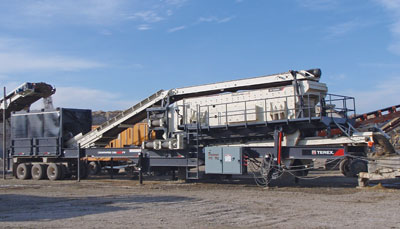 |
|
| The new Terex® Cedarapids CRS6203FV Portable Feeder/Screen Plant is shown operating with its revolutionary LJ-TSV Variable Slope Screen at 2.5°. The LJ-TSV Screen hydraulically raises up to 10° in 2.5° increments to best fit the application.
|
Astec recently released a multi-frequency screen, a model which offers the combined technology of conventional screens and high-frequency screens.
“Our new ProSizer 4200 multi-frequency chassis unit offers the ability to size concrete, RAP or virgin aggregate,” Reaver explains. “This unit also offers the ability to continue screening when conditions worsen due to higher moisture or more fines.” The ProSizer 4200 – the largest in its class – also incorporates a 4250 KPI-JCI variable speed drive Impactor to provide more screening capacity. In addition, it features quick setup and a remote-mounted radiator for dealing with dusty conditions.
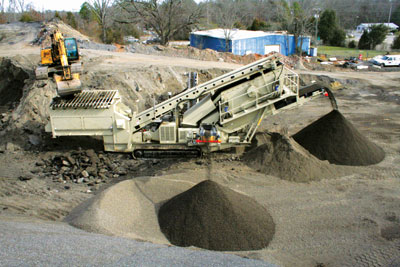 |
|
| KPI-JCI & Astec Mobile Screens have released a multi-frequency screen, which offers the combined technology of conventional screens with high frequency screens, capable of screening in a variety of applications. |
“In our track line, we’ve introduced the GT205S,” Reaver adds. “It’s a 5 x 20 track unit with a quick set-up time and a design that matches with our sister company’s (KPI-JCI) track plants and oversize conveyor belts.”
Derrick Corporation’s screens have also evolved to offer higher tonnage rates. Its recently launched high-capacity dewatering and sizing screens meet the strict cut-points for current aggregate products, says Don Ruppert, Derrick product/process engineer and aggregate division manager. “These new advancements provide easier downstream product management for waste fines,” he notes. “Derrick also now provides complete pond elimination with our new wash plants.” With the combined technologies of this system, all wash plant waste becomes a salable product, and 100 per cent of the waste water is returned to the plant.
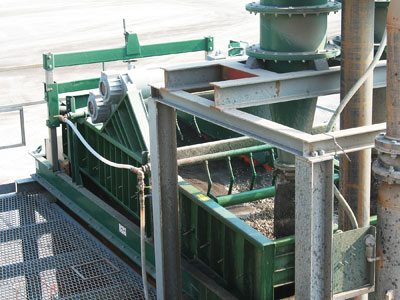 |
|
| The Derrick HI-CAP™ machine can dewater primary sand product, up to 300 TPH, at dryness levels of 90-92% solids (by weight).
|
At Telsmith Inc, the move to operating under ISO 9001:2008 standards for manufacturing procedures means tighter tolerances in their vibrating screens than ever before, says regional sales manager George Baker. Telsmith’s new Vibro-King TL inclined screens also represent a new approach – custom-designed to be completely compatible with a wide variety of media types, including wirecloth, rubber, urethane and grizzly bars. “It is the media type that drives the application of the screen design now versus the old days where it was vice versa,” Baker notes. “We recognize that modern screen media takes many forms and that flexibility in screen design is critical to achieving optimum performance.”
Telsmith screens have various deck designs with specific attributes to maximize performance when using different media types. Deck frame design options may include side-tension wire cloth, end-tension wirecloth, flat deck grids to accept urethane or rubber, modular urethane or rubber panels. “Telsmith application engineers carefully select the media type, openings, side plate thickness and all accessories to be installed to determine the proper model selection best suited for the job,” says Baker. The static and dynamic loads are calculated to ensure a properly-sized vibrator mechanism that will deliver the longest bearing life while achieving the proper speed, stroke and ‘G’ force for the application. “We have taken a modular approach, with 110mm, 130mm and 160mm bearing vibrator mechanisms available in single and dual-shaft assemblies for all applications,” Baker adds.
Telsmith has also recently created the TL ‘Never-Wear’ sealing system, which uses centrifugal force to cast oil away from the shaft casing to eliminate the need for a contact lip seal. “The inexpensive, urethane labyrinth seals in this system easily snap in, with the whole system eliminating the downtime and expense of repairing worn seals or shaft grooves,” says Baker. “Old-style double rubber lip seals on vibrating screens are known to lift off the polished surface due to age, heat build-up or excess oil volume, requiring the operator to disassemble the shaft assembly to replace the seal. We have solved this age-old problem.”
More user-friendly features
The latest Terex Minerals Processing Systems (Terex MPS) portable screen plants, the Terex Cedarapids CRS6203FV and CRS6203V, both feature the company’s new, patent-pending LJ-TSV Variable Slope Screen. “This design has the unique ability to vary the slope of our high G-force oval stroke screens to increase production and handle applications that normally would not be possible with traditional horizontal screens,” says marketing specialist Kevin Selk. “In addition to handling larger deck loads, the CRS6203FV plant’s large surge hopper with remote-controlled grid and variable speed belt feeder allows loader feeding from either side.” The hydraulic raising module lifts the LJ-TSV screen up to 10 degrees in 2.5-degree increments to best fit the application. The suspension and stabilization system features low-maintenance motion dampers, and eliminates installing and removing transport braces.
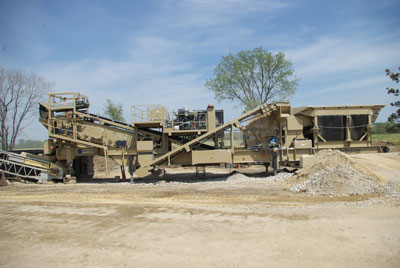 |
|
| In its chassis unit, Astec has released the ProSizer 4200, a larger chassis that can size concrete, RAP or virgin aggregate.
|
“An optional fines reject system removes excess fines to help achieve in-spec product without additional conveyors,” adds Selk. “The new CRS6203FV and CRS6203V portable plants featuring our next-generation screen handle a large number of applications. The plants also have many operator-friendly features, which include service platforms, conveniently located grease banks and cartridge-style belt flashing.”
Powerscreen’s recent offerings also focus on offering a user-friendly experience through stepped-up plant automation. “In 2011, we launched a wide-ranging upgrade of the plant control system and timed it to coincide with the redesign of our machines to bring them into compliance with the U.S. Tier 4/Stage IV emissions legislation,” says marketing manager Michelle Murphy. “In our mobile cone crusher line, this means a much more streamlined and integrated user interface.” In earlier versions, the system had a multiple controller setup, with different interfaces for engine, cone setting, choke control and machine power. Now, all engine and machine functions are controlled and operated from a single, intuitive colour interface.
“The menu has been designed to provide the operator with a balanced amount of process detail for any given task,” adds Murphy, “from tracking the machine to crusher setting to full plant operation. Diagnostics and alarms can be set up through the secondary control systems, which give the user a more thorough look at operational information, helping to very quickly identify and resolve faults.”
In early 2012, Powerscreen launched the Warrior 1400X screen, with the XH320X impact crusher and the X400S with Pre-Screen scheduled for release later this fall. “Next year, we will again be releasing new Powerscreen models with the ‘next generation’ of our plant automation advances as standard,” Murphy explains.
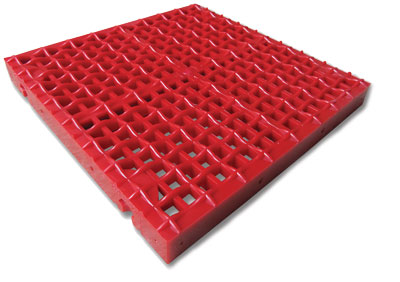 |
|
| Polydeck’s PolyWeave™ screen panel design represents one of several new screen surface designs under development to address specific customer screening issues.
|
Polydeck currently offers more than 1,000 screen panel designs with different surface features, opening sizes, fastenings and accessories. The surface of their newest modular polyurethane screen panel (PolyWeave) has a unique surface made up of a series of peaks and valleys. “[This surface design] has proven to be very effective for improving material stratification, enhancing screening efficiency, increasing drainage rates, and maintaining cut size longer than wire cloth and some existing flat surface designs,” says senior marketing manager Dennis Zeiger. “Because we’re the only screen media manufacturer to make all of our screen panels by an injection moulding process, we’re able to add features like these to the screen panel surface that nobody else can.”
Zeiger says Polydeck will soon launch a product line that utilizes a proprietary binary injection moulding process. “What that will mean to industry producers,” notes Zeiger, “is they will be able to receive the same outstanding Polydeck quality, performance and service on these new offerings for coarse opening (3 in.+), high-impact scalping applications as they do on their existing Polydeck modular screen media.”
Print this page